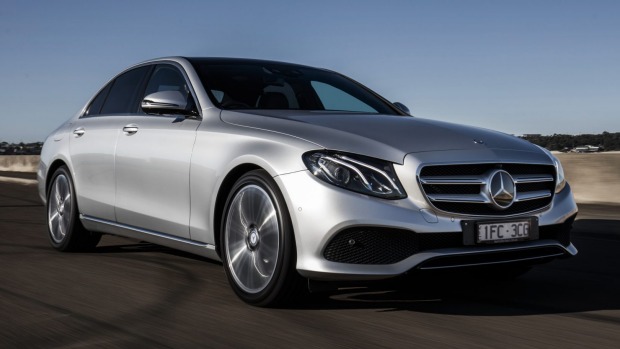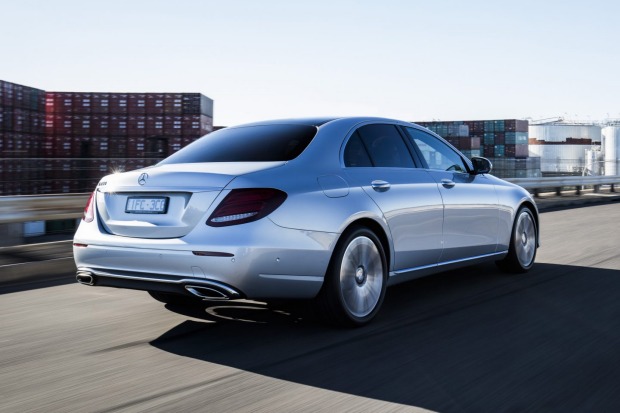Smart is the new cool.
Just as black-rimmed glasses have shifted from nerds to hipsters, and three-piece suits are back in vogue, car companies like Tesla have transformed emerging technologies like electric cars from geek to chic.
The Mercedes-Benz E-Class might never have been considered a trendy car, appealing more to conservative fat cats than cool cats, but the German car maker claims the latest mid-sizer is the smartest car in the world, brimming with more world firsts than a science fair, more computing power than a Boeing A380 and more gizmos and gadgets than a nerdy teenager. But is it as hip as it is square?
2016 Mercedes-Benz E-Class video review
We test the German brand's claim to creating the world's smartest car.
Well, considering it can virtually drive itself, park itself, has more mod cons than you'll ever need, and takes over the mantle as Mercedes-Benz' technology leader from the flagship S-Class, there is a lot to like – and a lot to talk about – with the tenth-generation E-Class.
Firstly, it arrives in Australia this month with the initial entry-level sedan variants – the E200, E220d and E350d – but will expand to become one of the widest model families in Benz's lineup, with at least three more sedans, wagons, coupes, high-performance AMG models and an all-new high-riding All Terrain crossover set to fill out showrooms.
Until then, the range starts at $89,900 (plus on-roads) for the E200 which is powered by a 2.0-litre turbo petrol four cylinder that generates 135kW/300Nm and consumes a claimed average of 6.6L/100km.
The E220d costs an extra $3000 and introduces an all-new 2.0-litre turbo diesel four cylinder– which is the foundation of a new family of engines that will include a re-born in-line six cylinder and features world-first emission-reduction technologies. It produces a healthy 143kW and 400Nm with a claimed average fuel consumption of just 4.1L/100km – significant improvements in both peak power and economy over the previous 2.1-litre turbo diesel.
The range-topper, for now at least, is the $134,900 (plus on-roads) E350d with a 3.0-litre twin-turbo V6 diesel that produces 190kW and 620Nm and has a claimed average fuel economy of 5.6L/100km.
A pair of higher-grade petrol-powered models will arrive before the end of the year in the E300 (with its upgraded 2.0-litre turbo petrol four producing 180kW/370Nm) and the E400 (which is powered by a 3.0-litre twin turbo V6 developing 245kW/480Nm and coming exclusively with Mercedes' 4Matic all-wheel drive system), while a plug-in hybrid E350e and the V6-powered AMG E43 will fill out the initial range early in 2017. The E300 will cost from $107,900 and the E400 is $139,900 while pricing and final specification details for the petrol-electric model and entry-level AMG will be confirmed closer to their showroom arrival.
But, even in the most basic trim, the E200 and E220d come fitted with an extensive list of features, including Benz' new-generation nine-speed automatic gearbox, automated emergency braking, adaptive cruise control with semi-autonomous driving and lane-changing, self-parking, artificial leather interior trim, dual-zone climate control, keyless entry and ignition, 18-inch alloy wheels and twin 12.3-inch digital displays – a customisable instrument cluster and a multimedia system with Bluetooth, sat nav and digital radio as standard - drawn down from the S-Class.
Building on the safety front, all E-Class models are fitted with nine airbags, the usual suite of electronic driver aids, an active bonnet to reduce injuries to pedestrians and a 360-degree camera with front and rear parking sensors.
Even more gear is introduced - or available as options on the E200 – the higher you move up the model line, with the E350d adding 20-inch AMG alloy wheels, air suspension, full leather upholstery with heated front seats, a head-up display, 13-speaker high-grade Burmester audio, a full length panoramic sunroof and Multibeam LED headlamps.

Having sampled just the E200 and E220d during our first local drive of the E-Class in Victoria's Yarra Valley this week, it is hard to comprehend if you need any more than the base variants.
With the E-Class built on the same rear-drive underpinnings as the latest C-Class, which won the 2014 Drive Car of the Year and remains our best pick for a luxury car under $80,000, but grabbing some of the luxury and convenience technologies of the flagship S-Class in a car that is larger – both inside and out – yet lighter and stronger than its predecessor, it is an impressive machine that re-sets numerous benchmarks in the executive sedan segment.
The 2.0-litre petrol is more than adequate with a linear power delivery and decent mid-range punch when the turbo picks up maximum boost that gives it a sense of being a bigger engine than it is, but it does require more from the broad spread of ratios in the nine-speed auto – changing gears invisibly but more often – to get the best out of it.
The turbo diesel, on the other hand, is a gem and feels both more energetic and relaxed while bringing a new level of refinement to oil burners. It effortlessly cruises at low engine speeds to save fuel, but also spins freely with a strong surge of torque when you need it for quick getaways or overtaking all the while without any of clackety, agricultural engine note that have blighted diesel engines in the past.
No matter which model you pick though, the E-Class is a beautiful car to drive with a peerless balance between comfort and handling. It is almost whisper quiet at any speed, the electric power steering is well-weighted and linear across the ratio, the brakes have good modulation through the pedal and the standard, conventional steel-spring suspension on 19-inch wheels is both compliant over bumps and sure footed in the bends. We also sampled an E220d on the optional air suspension with AMG 20-inch alloys with low-profile 35-series front and 30-series rear tyres, which felt just as plush on the open road but even more agile in the corners.
Beyond how it drives normally, Mercedes' latest semi-autonomous driving system has taken a huge stride forwards – and steps closer towards a full driverless car - with the E-Class. Where its lane-keeping assistance function in other models still feels binary in the way it reacts to road deviations (and only lasts for around 20 seconds before it demands the driver take full control), the E-Class is much smoother, its cameras and sensors can read more information that allows it to function on roads without clear markings and it can operate for up to a minute without the driver touching the steering wheel (even though Australian regulations still require full control of the vehicle at all times). It can also automatically change lanes after the indicator is activated for more than two seconds and it senses there is adequate space in the adjacent lane.
While it is more intuitive and smoother than ever before, particularly on clearly marked freeways, it still isn't completely foolproof as, during our drive, there were a few times where it still deviated off a country road.
Its self-parking function, on the other hand, is brilliant. While in other markets the system can be operated remotely from outside the car, even from the driver's seat it's amazing to watch it do its own thing. Unlike other systems which operate the steering only and require the driver to manage the accelerator and brake, once you've confirmed which free space you want to enter – either forwards or backwards – the E-Class does it all for you, even shuffling in and out (therefore changing between reverse and drive).
As much as the E-Class is about technology, it remains a luxury car first and foremost. And, from that perspective, its cabin borrows enough from the S-Class to make it feel both modern and classy but without robbing the limousine of its top-tier status and some of its theatre. The twin digital displays dominate the dashboard but somehow don't look as out of place in the E as they do in the S, partly due to new graphics and menus as well as the customisable instrument cluster when displaying its "progressive" theme, which projects a central tacho with integrated adaptive cruise information and supported on each side by a choice of nav, media, trip computer data.
Similarly, the new touch pad buttons on the steering wheel bring a sense of modern luxury. While it needs time to understand the functionality of the menus, once your familiar with how to navigate each screen the swipe action is both convenient and cool.
As for the more conventional elements, there's plenty of adjustment in the driving position, excellent vision all round, the build quality and materials are top notch and there's a sense of airiness about the cabin, generated both by its sheer space and the curving nature of the dashboard itself.
All in all, the tenth-generation E-Class is a smart car, on every front. It fast forwards the future of some technologies into today and improves on the technology of yesterday in others.
It might still be too conservative to be cool, but it is automotive geek chic.
2016 Mercedes-Benz E220d
On-sale: now
Price: $92,900 (plus on-road costs)
Engine: 2.0-litre four-cylinder turbo diesel
Power: 143kW at 3800rpm
Torque: 400Nm at 1600-2800rpm
Transmission: 9-spd automatic, RWD
Fuel use: 4.1L/100km

















Comments